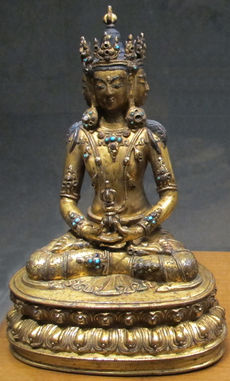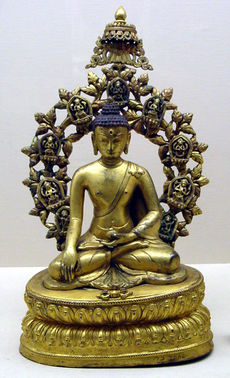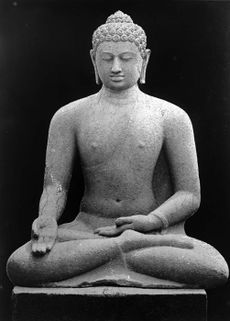Five Dhyani Buddhas/es: Difference between revisions
(Created page with "Cada Buda Dhyani está asociado con ciertos atributos y símbolos. Cada uno de ellos encarna una de las cinco sabidurías, que son un antídoto para los cinco venenos mortífe...") |
(Created page with "Cada Buda gobierna una de las direcciones del espacio y uno de los reinos cósmicos de éter, agua, tierra, fuego y aire. Los Budas Dhyani también personifican los cinco ''sk...") |
||
| Line 10: | Line 10: | ||
Cada Buda Dhyani está asociado con ciertos atributos y símbolos. Cada uno de ellos encarna una de las cinco sabidurías, que son un antídoto para los cinco venenos mortíferos que suponen el peligro supremo para el progreso espiritual del hombre y que le mantienen atado a la existencia mundanal. Los budistas enseñan que los Budas Dhyani son capaces de transmutar los cinco venenos en sus sabidurías trascendentes. El ''Libro tibetano de los muertos'' recomienda que el devoto medite en los Budas Dhyani de forma que sus sabidurías sustituyan a las fuerzas negativas que el devoto ha permitido que se apoderen de él. | Cada Buda Dhyani está asociado con ciertos atributos y símbolos. Cada uno de ellos encarna una de las cinco sabidurías, que son un antídoto para los cinco venenos mortíferos que suponen el peligro supremo para el progreso espiritual del hombre y que le mantienen atado a la existencia mundanal. Los budistas enseñan que los Budas Dhyani son capaces de transmutar los cinco venenos en sus sabidurías trascendentes. El ''Libro tibetano de los muertos'' recomienda que el devoto medite en los Budas Dhyani de forma que sus sabidurías sustituyan a las fuerzas negativas que el devoto ha permitido que se apoderen de él. | ||
Cada Buda gobierna una de las direcciones del espacio y uno de los reinos cósmicos de éter, agua, tierra, fuego y aire. Los Budas Dhyani también personifican los cinco ''skandhas'', componentes que conforman la existencia cósmica así como la personalidad humana. Estos componentes son conciencia, forma, sentimiento, percepción y volición. | |||
In addition, each Dhyani Buddha is associated with a specific color, ''[[mudra]]'' (hand gesture), symbolic animal that supports his throne, sacred symbol and ''bija'' (seed syllable). The bija represents the essence of the Dhyani Buddha. It can be used along with the sacred syllable ''Om'' and the Buddha’s name to create a mantra, a series of mystic syllables that have an esoteric meaning. In Hinduism and Buddhism disciples recite mantras to evoke the power and presence of a divine being. In some traditions, devotees use mantras in meditation to help them become one with the deity they are invoking. | In addition, each Dhyani Buddha is associated with a specific color, ''[[mudra]]'' (hand gesture), symbolic animal that supports his throne, sacred symbol and ''bija'' (seed syllable). The bija represents the essence of the Dhyani Buddha. It can be used along with the sacred syllable ''Om'' and the Buddha’s name to create a mantra, a series of mystic syllables that have an esoteric meaning. In Hinduism and Buddhism disciples recite mantras to evoke the power and presence of a divine being. In some traditions, devotees use mantras in meditation to help them become one with the deity they are invoking. | ||
Revision as of 03:56, 24 February 2020

Los Cinco Budas Dhyani son Vairochana, Akshobhya, Ratnasambhava, Amitabha y Amoghasiddhi. Los budistas tibetanos creen que el Adi-Buda, el ser primordial y más alto, creó a los Budas Dhyani con sus poderes meditativos.
Los Cinco Budas Dhyani son Budas celestiales a visualizar durante la meditación. La palabra Dhyani se deriva del sánscrito dhyana, que significa «meditación». Los Budas Dhyani también son denominados Jinas («vencedores » o «conquistadores») y son considerados como grandes sanadores de la mente y el alma. No son figuras históricas como Gautama Buda, sino seres trascendentes que simbolizan los principios o fuerzas divinas universales. Representan varios aspectos de la conciencia iluminada y son guías para la transformación espiritual. Los poderes meditativos también son poderes de los rayos secretos, y los Budas Dhyani poseen las claves de la maestría de los cinco rayos secretos.
Attributes
Cada Buda Dhyani está asociado con ciertos atributos y símbolos. Cada uno de ellos encarna una de las cinco sabidurías, que son un antídoto para los cinco venenos mortíferos que suponen el peligro supremo para el progreso espiritual del hombre y que le mantienen atado a la existencia mundanal. Los budistas enseñan que los Budas Dhyani son capaces de transmutar los cinco venenos en sus sabidurías trascendentes. El Libro tibetano de los muertos recomienda que el devoto medite en los Budas Dhyani de forma que sus sabidurías sustituyan a las fuerzas negativas que el devoto ha permitido que se apoderen de él.
Cada Buda gobierna una de las direcciones del espacio y uno de los reinos cósmicos de éter, agua, tierra, fuego y aire. Los Budas Dhyani también personifican los cinco skandhas, componentes que conforman la existencia cósmica así como la personalidad humana. Estos componentes son conciencia, forma, sentimiento, percepción y volición.
In addition, each Dhyani Buddha is associated with a specific color, mudra (hand gesture), symbolic animal that supports his throne, sacred symbol and bija (seed syllable). The bija represents the essence of the Dhyani Buddha. It can be used along with the sacred syllable Om and the Buddha’s name to create a mantra, a series of mystic syllables that have an esoteric meaning. In Hinduism and Buddhism disciples recite mantras to evoke the power and presence of a divine being. In some traditions, devotees use mantras in meditation to help them become one with the deity they are invoking.
“By repeating the mantra and assuming the mudra of any Buddha,” writes Buddhist monk and teacher Sangharakshita, “one can not only place oneself in correspondence or alignment with the particular order of reality which he personifies but also be infused with its transcendental power.”[1]
The mandala of the Five Dhyani Buddhas
Buddhists often depict the Dhyani Buddhas in a mandala. Mandala is a Sanskrit word meaning “circle,” translated in Tibetan texts as “center” or “what surrounds.” Some say the word derives from manda, meaning “essence.” The mandala as a circle denotes wholeness, completeness and the perfection of Buddhahood. The mandala is also a “circle of friends”—a gathering of Buddhas. Traditionally mandalas are painted on thangkas (scroll paintings framed in silk), drawn with colored sand, represented by heaps of rice, or constructed three-dimensionally, often in cast metal. A Dhyani Buddha is positioned in the center as well as on each of the cardinal points of the mandala.
A mandala is a sacred, consecrated space where no obstacles, impurities or distracting influences exist. Buddhists use mandalas to aid them in meditation and visualization. “All mandalas,” writes Tibetologist Detlef Lauf, “originate from the seed-syllables, or bija-mantras, of the deities. During meditation upon these mantras, an elemental radiance of light develops, from which comes the image of the Buddhas.... The whole external mandala is a model of that spiritual pattern which the meditating individual sees within himself and which he must endeavour to experience in his own consciousness.”[2]

Variochana
The name Vairochana means “He Who Is Like the Sun” or “The Radiating One.” Vairochana represents either the integration of, or the origin of, the Dhyani Buddhas. His wisdom is the Wisdom of the Dharmadhatu. The Dharmadhatu is the Realm of Truth, in which all things exist as they really are. Vairochana’s wisdom is also referred to as the All-Pervading Wisdom of the Dharmakaya, the body of the Law, or the absolute Buddha nature. It also represents the causal body around the I AM Presence in the Chart of Your Divine Self.
Vairochana’s transcendent wisdom reveals the realm of highest reality and overcomes the poison of ignorance, or delusion. His wisdom is considered to be the origin of, or the total of, all the wisdoms of the Dhyani Buddhas.
Vairochana is usually located in the center of mandalas of the Dhyani Buddhas. According to some texts, he is positioned in the East. His color is white (or blue), symbolizing a pure consciousness. He rules over the element of ether and embodies the skandha of consciousness. In some systems, he is associated with the skandha of form.
His symbol is the dharmachakra, the wheel of the teaching, or the wheel of the Law. It denotes the teaching of the Buddha. Its eight spokes represent the Noble Eightfold Path, which Gautama revealed in his first sermon after his enlightenment. Vairochana’s lotus throne is supported by the lion, symbol of courage, boldness and an eager, advancing spirit.
His mudra is the dharmachakra mudra, the gesture of turning the wheel of the teaching. Because he embodies the wisdom of all Buddhas, Vairochana’s bija is the universal sound Om. His mantra is Om Vairochana Om.
Vairochana has recently become the eighth member of the Karmic Board, a group of spiritual overseers who adjudicate the karma for the evolutions of this system of worlds. He explained his specific role on the Karmic Board, granted by dispensation of all Buddhas:
My role shall be to assist those who have light who are sincere but who have strayed from the track of Reality, considering that their karma was too hard to bear.... I would teach all who apply to me what they need to know to make it all the way Home.
I would teach a certain level of souls who, with my support and the support of all of us, will have the opportunity to make it, whereas without that support, they might not make it....
I will help you. I will prepare you. I will show you how in profound humility and with inner strength you will master all flaws of character that are open doors to negative spirals and negative traits, and you will get on with your reason for being—why you embodied in this life in the circumstances you find yourselves—and you will know that you embodied to balance your karma so that you can fulfill your mission.[3]

Akshobhya
The name Akshobhya means “Immovable” or “Unshakable.” Akshobhya’s Mirrorlike Wisdom reflects all things calmly and uncritically and reveals their true nature. One text says, “Just as one sees one’s own reflection in a mirror, so the Dharmakaya is seen in the Mirror of Wisdom.”[4] The Mirrorlike Wisdom antidotes the poison of hatred and anger.
In the mandala of the Five Dhyani Buddhas, Akshobhya is usually positioned in the East (at the bottom) but he is sometimes placed in the center. His color is blue. He rules over the element of water and personifies the skandha of form. In some systems, he is associated with the skandha of consciousness. Akshobhya’s lotus throne is supported by the elephant, symbol of steadfastness and strength.
His symbol is the vajra, also called thunderbolt or diamond scepter. The vajra denotes enlightenment, the indestructible, adamantine nature of pure consciousness, or the essence of Reality. In some traditions, the vajra signifies the union of man and the Buddha; one end of the vajra symbolizes the macrocosmic realm of the Buddha and the other end the microcosmic realm of man.
Akshobhya’s mudra is formed by his right hand and is the bhumisparsha mudra, the earth-touching gesture. It denotes unshakability. This is the mudra Gautama Buddha used to summon the earth to witness to his right to attain enlightenment when he was challenged by Mara, the Evil One.
Akshobhya’s paradise is Abhirati, the Land of Exceeding Great Delight. Buddhists believe that whoever is reborn there cannot fall back to a lower level of consciousness. Akshobhya’s bija is Hum, and his mantra is Om Akshobhya Hum.
Akshobhya says:
The way seems intricate, but the intricacy is the intricacy of karma woven and rewoven. The intricate undoing of the threads of karma is what seems to make the Path so complicated. But when all is said and done and all of those components of the threads of karma are consumed in one great violet-flame bonfire, you will come to know, and you will remember one day that I have said the entering in is simplicity itself, humility itself, purity itself.[5]

Ratnasambhava
The name Ratnasambhava means “the Jewel-born One” or “Origin of Jewels.” The Three Jewels are the Buddha, the Dharma and the Sangha. The Buddha is the Enlightened One, the Guru, the hub of the wheel of the Law. The Dharma is the Teaching, or the Law. The Sangha is the Community.
Ratnasambhava transmutes the poison of pride (spiritual, intellectual and human pride) into the Wisdom of Equality. Tibetan Buddhists teach that with the Wisdom of Equality one sees all things with divine impartiality and recognizes the divine equality of all beings. One sees all beings and the Buddha as having the same nature.
Ratnasambhava is the Dhyani Buddha of the South. His color is yellow, the color of the sun in its zenith. Ratnasambhava rules over the element of earth and embodies the skandha of feeling or sensation.
He is sometimes shown holding his symbol, the ratna (jewel) or chintamani (wish-fulfilling jewel that grants all right desires). The chintamani is a symbol of the liberated mind.
Ratnasambhava’s throne is upheld by a horse, denoting impetus and liberation. His mudra is the varada mudra. It is the gesture of giving, or charity, which portrays him offering compassion and protection to his disciples. His bija is Tram and his mantra is Om Ratnasambhava Tram.
Ratnasambhava says:
O blessed ones, God has so valued each one that to each one he has given the very image of himself, the I AM Presence, the Holy Christ Self, in whose image you are made. Find the jewel, find the jewel. Find the Sangha, find the Buddha, find the Dharma, all locked within the inner divine spark.[6]

Amitabha
The name Amitabha means “Infinite Light.” Amitabha’s Discriminating Wisdom conquers the poison of the passions—all cravings, covetousness, greed and lust. With this wisdom, the disciple discerns all beings separately yet knows every being as an individual expression of the One.
In the mandala of the Dhyani Buddhas, Amitabha is positioned to the West. His color is rose (red), the color of the setting sun. He rules over the element of fire and personifies the skandha of perception. Thus, the eye and the faculty of seeing are associated with Amitabha. The peacock with “eyes” on its plumes is his throne-bearer. The peacock symbolizes grace.
Amitabha’s symbol is the padma, or lotus. In Buddhism, the lotus can symbolize many things, including spiritual unfoldment, purity, the true nature of beings realized through enlightenment, and compassion, the purified form of passion.
Devotees aspire to be reborn in Amitabha’s Western Paradise, known as Sukhavati, where conditions are ideal for attaining enlightenment. His mudra is the dhyana (meditation) mudra. His bija is Hrih and his mantra is Om Amitabha Hrih.
Some consider Amitabha to be synonymous with Amitayus, the Buddha of Infinite Life. Others honor Amitayus as a form of Amitabha or as a separate Buddha. Amitayus is usually depicted holding a vessel of the elixir of immortal life. A tiny ashoka-tree often sprouts from the cover of his vessel, representing the union of the spiritual and the material.

Amoghasiddhi
The name Amoghasiddhi means “Almighty Conqueror,” or “He Who Unerringly Achieves His Goal.” Amoghasiddhi’s All-Accomplishing Wisdom, or Wisdom of Perfected Action, antidotes the poison of envy and jealousy. This wisdom confers perseverance, infallible judgment and unerring action.
Amoghasiddhi represents the practical realization of the wisdoms of the other Dhyani Buddhas. He is described as the Dhyani Buddha of the realization of the bodhisattva path. A bodhisattva is one who has forgone the bliss of nirvana with a vow to first liberate all beings.
Amoghasiddhi is the Dhyani Buddha of the North. His color is green, signifying the sun at midnight. He rules over the element of air and embodies the skandha of volition, also called the skandha of mental phenomena or tendencies of mind. His symbol is the vishvavajra, or double vajra. It is made of two crossed vajras and symbolizes the highest comprehension of truth and the spiritual power of a Buddha.
The throne of Amoghasiddhi is supported by garudas—mythical figures, half man and half bird. In relation to Amoghasiddhi, Lama Govinda says the garuda symbolizes “man in transition towards a new dimension of consciousness,... the transition from the human to the superhuman state, which takes place in the mysterious darkness of the night, invisible to the eye.”[7]
Amoghasiddhi’s mudra is the abhaya mudra. It is the gesture of fearlessness and protection. The right hand is raised to shoulder height with palm forward. The left hand is cupped in the lap or placed at the heart, fingers pointing inward. Amoghasiddhi’s bija is Ah and his mantra is Om Amoghasiddhi Ah.
See also
Sources
Mark L. Prophet and Elizabeth Clare Prophet, The Masters and Their Retreats, s.v. “The Five Dhyani Buddhas.”
- ↑ Bhikshu Sangharakshita, A Survey of Buddhism, rev. ed. (Boulder, Colo.: Shambhala with London: Windhorse, 1980), p. 372.
- ↑ Detlef Ingo Lauf, Secret Doctrines of the Tibetan Books of the Dead, trans. Graham Parkes (Boston: Shambhala, 1989), p. 105; Tibetan Sacred Art: The Heritage of Tantra (Berkeley: Shambhala, 1976), p. 120.
- ↑ Vairochana, “Balance Your Karma: Take the High Road,” Pearls of Wisdom, vol. 37, no. 3, January 16, 1994.
- ↑ Indrabhuti, Jnanasiddhi, quoted in Lama Anagarika Govinda, Insights of a Himalayan Pilgrim (Berkeley: Dharma Publishing, 1991), p. 113.
- ↑ Akshobhya, “Becoming Real!” Pearls of Wisdom, vol. 37, no. 4, January 23, 1994.
- ↑ Ratnasambhava, “Elements of Being,” Pearls of Wisdom, vol. 37, no. 6, February 6, 1994.
- ↑ Lama Anagarika Govinda, Foundations of Tibetan Mysticism (1960; reprint, New York: Samuel Weiser, 1969), p. 262; Insights of a Himalayan Pilgrim (Berkeley: Dharma Publishing, 1991), p. 84.
